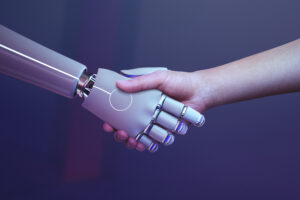
Source: Freepik
Artificial Intelligence (AI) is becoming more and more known. Not least by technical innovations, like ChatGPT. In addition to research, people from outside the field are slowly making use of the useful properties of Artificial Intelligence. You want to take part in the conversation? We’ll explain the features of Artificial Intelligence and how you can use them in your student life.
What is Artificial Intelligence?
Basically, the characteristic of artificial intelligences is to recognize repetitive patterns. Artificial intelligences can evaluate data sets within seconds and adapt their behavior to different situations. Artificial intelligence belongs to computer science. Artificial intelligence, in turn, can be divided into different areas. A typical focus of Artificial Intelligence is Machine Learning.
Machine Learning
Machine learning currently makes up the bulk of AI that is already being used in everyday life today. Central to this is the training of computers. For this purpose, the computer is fed with data with which the artificial intelligence gathers experience. After successful implementation, the experiences are used to continuously improve the computer.
The general goal of artificial intelligences is to solve individual application problems through algorithms. The algorithms are adapted to solve an application problem. The learning models are similar to human thinking. They can be divided into three groups: Supervised Learning, Unsupervised Learning and Reinforcement Learning.
Supervised Learning – Classification of Data
In the supervised learning model, known input data and corresponding reactions are used. The algorithm learns the desired behavior from this. For example, supervised learning can then be used to estimate real estate prices. Quite classically, the learning model can also be trained on classifications. The computer can learn to recognize the difference between a cat and a dog on its own, based on data sets.
Unsupervised Learning
In the unsupervised learning model, no known input data with associated responses are used. The algorithm must independently recognize patterns and structures in the data without being given the correct answers. Unsupervised learning is particularly well suited for tasks such as cluster analysis, where similar data points are grouped together. It can also be used to identify anomalies or outliers in the data. Unlike supervised learning, where a clear goal is specified, unsupervised learning is more flexible and can extract new relationships and insights from the data that were not previously known.
Reinforcement Learning – Reward as Incentive
In reinforcement learning, the algorithm learns through experience and interaction with its environment. Similar to the brain, the algorithm receives positive feedback in the form of a reward if it delivers correct results. It is particularly suitable for simulations or automated environments. One example is schedule generation and effort estimation in projects.
Use of AI in Everyday University Life
Typically, one is familiar with artificial intelligence from large research projects. However, research is not only conducted on AI per se. Properties of AI can also be applied to other fields. Project planning, for example, has made this its own – these can also be transferred to everyday student life.
In joint projects by students, for example, the duration of a project can be precisely determined and monitored. If factors change, the project duration can then be automatically recalculated.
The same principle can be applied to the resources of a project: If there is a change in resources, the AI can make automatic adjustments.
In addition, recurring tasks can be completed and adjusted automatically. This can be, for example, the creation of schedules, the estimation of an effort or the allocation of resources. Artificial intelligence is therefore a solution for routine tasks. The advantage of taking on routine tasks then lies in the time saved.
There is already software on the market for use in projects. One example is concrete AI tools that allow students to use artificial intelligence in their projects. Whether it’s estimating real estate prices, analyzing large data sets for scientific research, or automating repetitive tasks, these tools offer practical applications and allow students to fully realize the potential of AI. Although the market does not yet offer an all-encompassing solution, it is likely that AI will become increasingly important and continue to make working on projects easier.
Responsible for the content of this article are Malak Mostafa and Madeline Lebrun.
Sources:
[1] https://www.projektmagazin.de/artikel/kuenstliche-intelligenz-ki-projektmanagement
[2] https://datasolut.com/wiki/unsupervised-learning/




